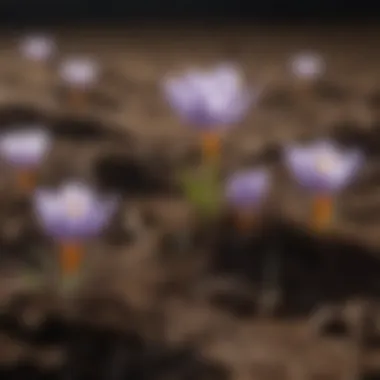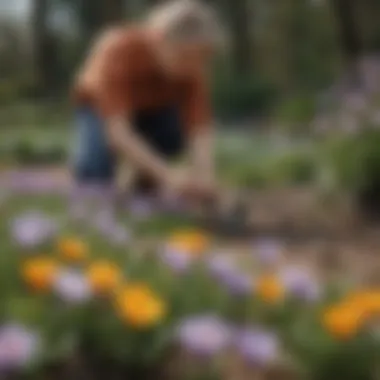Crocuses: Planting Tips for Spring Blooms


Intro
Crocuses are a symbol of spring, appearing as vibrant harbingers of warmer weather. Their early blooms can brighten gardens, making them a favorite among gardening enthusiasts. Understanding when to plant crocuses is critical for their growth and overall health. This section will outline the essential factors that govern the timing of their planting as well as the influence of environmental conditions.
Ideal Planting Times
Crocuses can be generally categorized into two groups: those that bloom in autumn and those that bloom in spring. Each type has specific planting times that correlate with regional climate conditions.
- Spring-Blooming Crocuses:
- Autumn-Blooming Crocuses:
- Planting Time: The best time to plant spring-blooming crocuses is in the early fall, typically between late September and early November. This allows the bulbs to establish roots before the winter.
- Flowering Season: They generally bloom between February and April, depending on local climate.
- Planting Time: These varieties should be planted in late summer, around July to August.
- Flowering Season: These crocuses can be expected to bloom during the fall months.
Timing is vital in ensuring that the bulbs experience the necessary chill periods for optimal flowering cycles. Early planting can lead to disappointment as they may not flourish as expected.
Factors Influencing Growth
Several elements will impact the growth of crocuses and their eventual blooming. Awareness of these factors can help achieve a stunning display.
- Soil Quality: Well-drained soil is ideal, as crocuses do not thrive in overly moist or soggy environments.
- Sunlight Exposure: Crocuses prefer full sun or partial shade. Positioning them in a location where they receive a good amount of sunlight can lead to healthier blooms.
- Watering Needs: During the growing season, water the bulbs moderately. Overwatering can lead to bulb rot, while too little can inhibit growth.
Care Instructions
Proper care is essential for crocus health. Here are some tips:
- Fertilization: Use a balanced, slow-release fertilizer during the early growing season to promote healthy growth.
- Mulching: Apply a layer of mulch to retain moisture and maintain soil temperature.
- Deadheading: After blooming, remove spent flowers to redirect energy back to the bulbs.
Seasonal Considerations
Be mindful of seasonal variations that could affect the crocus growing process. Temperature fluctuations during the fall can influence the planting period.
- Frosts: Late frosts in early spring can impact the blooming period.
- Warm Spells: Unexpected warmer weather in fall may encourage premature growth if bulbs are planted too late.
Prolusion to Crocuses
Crocuses are among the first indications of spring. Their vibrant colors awaken the garden after a long winter. This section introduces the reader to crocuses, focusing on their diverse varieties and roles in garden design. Understanding these elements is crucial when planning the planting of crocuses for the best visual impact and healthy growth.
Overview of Crocus Varieties
Crocuses belong to the Iridaceae family and come in around 90 species. These species exhibit a wide range of colors, including purples, yellows, and whites. Some common varieties include:
- Crocus vernus (Spring Crocus): Known for its early blooms, often between February and April.
- Crocus chrysanthus (Golden Crocus): Famous for its bright yellow flowers and smaller size.
- Crocus tommasinianus (Tommy Crocus): Characterized by its naturalizing ability, spreading well in gardens.
Choosing the right variety affects the garden’s aesthetics and growth success. Each type may have different planting and care needs, influencing gardeners’ choices.
Significance of Crocuses in Gardens
Crocuses serve more than just an ornamental role in gardens. They are valuable for several reasons:
- Early Blooming: Crocuses are among the first flowers to bloom. Their early bloom helps bring life and activity back into gardens, attracting pollinators before many other flowers.
- Naturalizing Ability: Many species, especially Crocus tommasinianus, are great for naturalizing. They spread over time, filling spaces with color each spring.
- Diverse Applications: Crocuses work well in borders, rock gardens, and lawns. They can add patches of color in unexpected places, enhancing landscape design.
- Hardiness: They are resilient, surviving in various climates. This makes crocuses a fitting choice for gardeners in different regions.


In summary, understanding the significance of crocuses helps gardeners make informed choices about their planting and care. This knowledge aids in creating vibrant and dynamic garden spaces.
Understanding Planting Times
Understanding when to plant crocuses plays a key role in their overall health and flowering ability. Proper timing ensures that bulbs develop the necessary roots before winter, preparing them for a vibrant spring display. In order to attain successful growth, it is essential to consider several aspects, including general planting principles, climatic influences, and the timing of soil preparations. Each of these factors must align to create an optimal environment for crocuses.
General Planting Guidelines
In general, crocuses are planted in the fall before the ground freezes. This timing gives the bulbs a chance to settle in and begin establishing roots. The planting depth is typically three times the height of the bulb, allowing enough room for growth while ensuring adequate moisture retention. Bulbs should be placed in well-draining soil to avoid rot. Spacing between each bulb must also be considered. A recommended distance of about 3 to 5 inches allows adequate airflow and minimizes competition between plants once they bloom.
Climate Considerations
When discussing climate, it is vital to take into account both local temperatures and seasonal patterns. Crocuses thrive in temperate climates with cold winters and warm springs. Regions with mild winters may experience issues, as bulbs may not achieve the necessary chilling period, which can impact flowering. It's also important to monitor microclimates within your garden. Areas that retain heat, like south-facing slopes, may require adjustments to planting times to compensate for earlier warming.
Soil Preparation Timing
Timing soil preparation is an often overlooked aspect of planting bulbs. Ideally, preparing the soil for crocuses should be done a few weeks prior to planting. This involves turning the soil and removing debris while also incorporating organic matter. Testing the soil pH is helpful, as crocuses prefer neutral to slightly alkaline conditions, typically around 6 to 7.5. Correct soil conditioning contributes to the long-term growth of crocuses, ensuring they receive necessary nutrients, improving drainage, and enhancing overall resilience.
Proper planting time influences growth success significantly. Always prioritize local climate factors and soil readiness for best results.
Optimal Planting Season
The optimal planting season for crocuses is an element crucial to their success in blooming. These flowers are not only resilient but also sensitive to their environment. Understanding when to plant them can impact their growth and flowering potential significantly. Timing ensures that crocuses will be well-prepared to face weather changes and seasonal shifts. Therefore, identifying the right planting window is key for every gardener who wishes to see their crocus bulbs thrive.
Fall Planting: The Best Time
Fall is widely regarded as the best time for planting crocuses. The reasons for this are mainly centered around temperatures and soil conditions that favor bulb growth. As the air cools but the soil remains warm, bulbs initiate their root systems without being pushed into premature growth. This leads to larger, healthier flowers in the spring.
When you plant in fall, it's essential to time it properly. Ideally, planting should be done six to eight weeks before the first hard frost. This allows time for the roots to establish. In many regions, this means September to early November. During this time, the soil moisture is generally consistent, reducing the need for additional watering. Furthermore, fall planting enables crocuses to naturally prepare for their dormancy period during the winter.
Spring Planting Considerations
Spring planting may sometimes be necessary due to various reasons, such as a late decision to plant or unfavorable fall conditions. However, it comes with its own set of challenges. When planting in spring, the bulbs may not establish as robustly as those planted in fall. High soil temperatures can lead to quick growth that strains vital resources. Therefore, if opting for spring planting, it's best to plant as soon as the ground is workable. This can vary by region but generally occurs between March and early May.
Additionally, spring plantings typically require more attention to moisture levels since the soil may dry out faster. Furthermore, pay close attention to weather forecasts during this period to protect the developing bulbs from unexpected frosts. The careful balance between heat and moisture is crucial for successful spring blooms.
Regional Variations in Planting Times
Planting times for crocuses can differ widely based on geographical location. Regions with mild winters may allow for earlier planting in the fall, while colder climates may necessitate later planting. For instance, in southern climates, gardeners can often plant by mid-September. In contrast, those in northern latitudes may wait until late October to ensure that the bulbs are not affected by early frost.
"Understanding your local climate is vital for the successful cultivation of crocuses. Customizing your planting schedule based on regional weather conditions increases the chances of vibrant spring blooms."
Moreover, altitude plays a role in planting times, too. In high-altitude areas, temperatures can be significantly lower, affecting the growth cycle. Therefore, local advice from gardening centers or community groups can provide tailored insights into optimal planting times for specific regions.
Factors Influencing Growth
Understanding the various factors influencing the growth of crocuses is essential for achieving robust and vibrant blooms. Several elements come into play, and gardeners must take these into account to maximize the plants' potential. Key factors include temperature, sunlight, and watering needs.
Temperature and Weather Patterns
Temperature has a significant effect on the development of crocuses. These flowers prefer cool conditions, typically thriving in temperatures between 50°F and 60°F (10°C and 15°C). If temperatures rise too much too early in the season, crocuses may bloom prematurely and become vulnerable to frost. This timing can disrupt their growing cycle, leading to lower flower quality.


Weather patterns also greatly influence crocus growth. Consistent and gentle moisture is essential, especially during the early stages. Excessive rainfall or sudden temperature shifts can lead to bulb rot or damage. Observing local weather forecasts can guide gardeners on the best times to plant and care for their crocuses, ensuring optimal growth.
Sunlight Requirements
Sunlight plays a crucial role in the health and productivity of crocuses. These flowers thrive best in full sun but can tolerate partial shade. Ideally, they should receive at least six hours of direct sunlight per day. In shaded areas, crocuses may appear leggy and fail to produce their vibrant hues effectively.
Proper placement of crocus bulbs not only enhances their growth but also promotes a more substantial floral display. Gardeners should assess potential planting locations for adequate light exposure. Observing the sunlight patterns in your garden through different seasons will help in selecting the ideal spot for planting crocuses.
Watering Needs Before and After Planting
Watering is a critical consideration when cultivating crocuses. The bulbs need well-drained soil to prevent rot, and overwatering can be detrimental. In the planting phase, ensuring the soil is moist but not oversaturated is vital. After planting, a light watering regime is recommended to establish the roots without flooding the bulbs.
Once the crocuses begin to grow, additional watering may be unnecessary unless there is prolonged drought. Ideally, the soil should remain slightly moist, especially during the blooming period. However, too much moisture should be avoided. Monitoring the conditions and adjusting the watering frequency will help maintain the health and vibrancy of the crocus flowers.
Remember, balanced moisture is key for thriving crocuses. You want them happy, not soggy.
Considering these factors will broaden your understanding of what crocuses need to thrive. A thoughtful approach to temperature, sunlight, and watering will lead to better results in the garden.
Planting Techniques
The planting techniques employed for crocuses play a critical role in their overall growth and development. Selecting appropriate methods ensures not only optimal blooming but also the health of the plants throughout their lifecycle. By understanding and applying effective techniques, gardeners can create a favorable environment for these hardy flowers. This section will delve into essential considerations such as choosing the right location, determining the depth of planting, and ensuring adequate spacing between the bulbs.
Choosing the Right Location
When selecting a location for planting crocuses, several key factors need to be considered. The ideal site should receive plenty of sunlight, as crocuses thrive in bright conditions. A spot that gets at least six hours of sunlight a day is preferable. Avoid shaded areas where they may not perform well. Additionally, good drainage is crucial. Standing water can lead to bulb rot, so choose locations that are well-drained and do not hold excess moisture.
For those maintaining gardens in different climates, remember that positioning may also vary based on regional temperatures. In warmer areas, some afternoon shade can protect the plants from scorching heat. Furthermore, proximity to taller plants can provide shelter from surprising gusts of wind, which may be beneficial for the delicate blooms.
Depth of Planting
Planting depth has a significant impact on the growth of crocus bulbs. The general guideline is to plant bulbs at a depth of about three to four inches (around 7.5 to 10 cm). This depth is adequate for most species, allowing them to root properly while also being secure from surface disturbances, like soil erosion or weather changes.
If the bulbs are planted too deeply, they may struggle to break through the soil, impacting their growth. Conversely, if planted too shallowly, they face risks of exposure to harsh weather or damage from pests. Careful attention to depth ensures the bulbs can establish strong roots and develop vigorous flowering habits.
Spacing Between Bulbs
Adequate spacing between crocus bulbs is equally important. Crowding can lead to competition for nutrients, water, and sunlight, which may stifle the growth and health of individual plants. Aim to space the bulbs approximately three to four inches apart to give them room to flourish. This approach allows each plant ample access to resources while creating a visually appealing arrangement as they bloom.
When planting in groups, consider using a staggered pattern. This can lead to a more natural look and enhance the overall aesthetics of the garden. Making use of diverse color combinations can create stunning contrasts in the flowerbed, providing further enrichment to the landscape.
A well-planned strategy on planting techniques is vital for ensuring crocuses deliver their vibrant show come spring.
In summary, focusing on planting techniques—location, depth, and spacing—ensures the optimal growth of crocuses. By adhering to these strategies, gardeners can enhance the likelihood of healthy blooms and a successful gardening experience.
Post-Planting Care
Post-planting care is a vital phase in the cultivation of crocuses. Once you have planted your bulbs, the care you provide can significantly impact their health and blooming potential. This section covers key practices such as fertilizing, mulching, and managing pests and diseases. Each step contributes to a robust growth environment that fosters beautiful blooms. Understanding these practices is essential for both novice and experienced gardeners alike.
Fertilizing After Planting
Fertilizing after planting is an important step to ensure that crocuses have the necessary nutrients to thrive. Bulbs store food for their initial growth, but supplemental fertilization can enhance development. A slow-release fertilizer is often recommended. Apply it to the soil when you plant the bulbs. It should be low in nitrogen to prevent foliage overgrowth at the expense of blooms.


Application rates vary, but following the manufacturer’s instructions is essential to avoid over-fertilization, which can harm the plants. Fertilizing again after blooming can help store energy for next season's growth. This practice is beneficial for subsequent blooms and improves the overall health of the plants.
Mulching Techniques
Mulching is another crucial aspect of post-planting care for crocuses. A good layer of mulch can help regulate soil temperature and retain moisture. Organic mulches, such as shredded leaves or bark, are particularly effective. They also decompose over time, enriching the soil.
Apply a layer of mulch about two to three inches thick after planting. This will also help suppress weeds that might compete for nutrients. Ensure that the mulch does not touch the bulbs directly; this prevents rot and allows for healthy growth. Regularly check the condition of the mulch, replenishing it as it breaks down.
Pest and Disease Management
Managing pests and diseases is essential for maintaining the health of crocuses. Common threats include bulb rot, fungal infections, and pests such as aphids and thrips. To minimize these risks, ensure proper soil drainage. Overly saturated soil can lead to bulb rot. Additionally, maintaining air circulation around the plants can deter fungal growth.
Using a preventive fungicide during the active growing season can also help, especially if conditions are humid or wet. For pests, consider using insecticidal soap as a safe treatment. Regular inspections of your plants can help catch these issues early, allowing for timely intervention. Good management practices lead to vibrant displays and a healthy garden overall.
Common Challenges
In gardening, every flower bed comes with its unique set of challenges. Crocuses, despite being resilient, are no exception. Understanding these common challenges is crucial for ensuring that these flowers thrive and display their beauty in spring. Various factors such as climate conditions, soil type, and surrounding plants can affect crocus growth. Addressing these issues effectively can lead to a rewarding gardening experience.
Frost Damage Prevention
Frost can be a significant threat to young crocus plants, especially in early spring when the flowers start to emerge. When planted too early, crocus buds can be exposed to freezing temperatures, which can cause wilting or death. To prevent frost damage, it is essential to know the typical frost dates in your region. Utilizing protective measures such as frost cloths or simply delaying planting until the risk of frost passes can make a big difference.
"The key to managing frost risk is timing. Planting just after the last expected frost can prevent much heartache."
Ensure you monitor local weather reports. Knowing when to expect late frosts will help you make informed decisions. Additionally, planting in well-drained soil can reduce frost severity on the roots.
Overwatering Risks
While crocuses need moisture, they do not do well in overly saturated soil. Too much water can lead to bulb rot and other diseases that can devastate your blooms. A critical aspect of caring for crocuses is establishing a watering schedule that considers current weather conditions and soil moisture levels. It is recommended to water lightly but consistently to keep the soil slightly moist, especially in periods of little rainfall.
Here are some tips to prevent overwatering:
- Check Soil Moisture: Use a finger to gauge the moisture level. If the soil feels damp, skip watering.
- Improve Drainage: Ensure the planting area has well-draining soil. Consider amending with sand or compost if drainage is poor.
- Monitor Rainfall: Keep an eye on rainfall amounts. Adjust your watering scheme according to wet or dry spells.
Competing Vegetation Control
The presence of weeds or other plants can dramatically impact the growth of crocuses. These plants can compete for crucial resources like nutrients, water, and sunlight. Regular garden maintenance is effective in managing this challenge. A few methods to keep competing vegetation at bay include:
- Mulching: Apply a layer of mulch around the crocuses after planting. This can suppress weeds while retaining moisture.
- Hand Weeding: Regularly check the garden bed and remove any unwanted weeds that appear as crocuses begin to sprout.
- Crop Rotation: If other plants are planted nearby, consider rotating them. This limits competition and can help maintain soil health.
By focusing on these challenges, gardeners can enhance their crocus growing experience, leading to vibrant and healthy blooms. Proper prevention and care strategies help ensure that crocuses flourish without being hindered by environmental and biological challenges.
End
In this article, we explored the essential aspects of planting crocuses to ensure optimal growth. Understanding when to plant these flowers is not just about timing; it also encompasses soil conditions, climate, and specific care needs. The significance of proper planting cannot be overstated. A well-timed planting results in healthier plants and allows for a vibrant spring display, which enhances the aesthetic appeal of any garden.
Summary of Key Points
Several key points emerged during our discussions:
- Optimal Planting Season: Fall is often considered the best time to plant crocuses. However, spring planting can also be effective, depending on the specific variety and regional climate.
- Soil Preparation: Ensuring well-draining soil is crucial for preventing bulb rot. Adequate soil preparation should take place before planting to create the best environment for growth.
- Post-Planting Care: Once planted, crocuses require specific care, including watering and potential fertilizing. Mulching can protect bulbs from fluctuating temperatures.
- Common Challenges: Awareness of potential challenges, such as frost damage and competition from weeds, is essential for successful cultivation.
Encouragement for Gardeners
For homeowners and gardening enthusiasts, growing crocuses can be a rewarding endeavor. Start with proper research on the variety best suited for your region. Experiment with different planting techniques and care methods. Each season will bring new insights and experiences.
Gardening is as much about patience as it is about knowledge. With time and care, your crocus plants will thrive, offering beauty and cheer during the early weeks of spring. Remember, each bloom is a small triumph of nature and your commitment. Enjoy the process and happy gardening!



